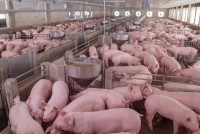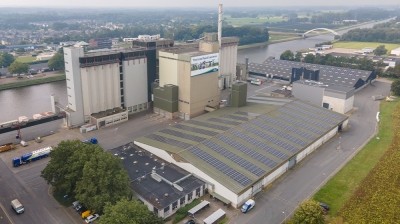ForFarmers innovation lead: ‘If you don’t take research leaps, you may not get the breakthroughs’

We asked Ad van Wesel, director of the NIC, to give us a deeper dive on the team’s work and how it ties in with the manufacturer’s commercial feed production priorities.
The innovation center consists of four teams: one focused on swine, one on ruminant related projects, another charged with poultry research and a fourth team working across species.
“We have a lot of projects on the go – some of those are termed maintenance projects – these are smaller-scale initiatives aimed at keeping our nutritional systems up to date. You don’t really gain additional customers from that kind of work, but you can lose customers if you don’t do it right. Every year, we try to also carry out small, incremental projects such as making slight improvements on the FCR of our feeds, for example. Then we also carry out several high impact projects.”
Maintenance projects are low risk, he said, in terms of costs. At the other end of the spectrum are the high-risk, high reward initiatives. “You can’t guarantee that those will always be 100% successful.”
The high-risk projects undergo an internal review process, he said, and will be paused if seen as unlikely to deliver. “You have to convince the steering committee a project will fly. They will look at the reward. We have a project on the go currently that could potentially work across species. If proved effective, it could be worth lots as we have big volumes at ForFarmers."
Networking
The NIC experts collaborate with academics and other international research entities. “We work with a R&D network. We have deliberately chosen not to have our own research farms. It was a choice. I think we are one of the few bigger companies that opted not to do that. Whenever we want to start development work, we immediately consider who is best placed to help us. If we want to test a product in a ruminant, in vitro, for example, we might go to a university in the US that we believe is leading in this regard. We don’t look to the literature to study such a testing method and then try to develop it ourselves. We team up with international experts. There are pros and cons to this approach but ultimately it allows us to have an external view on any research project, and it allows to focus on its practical application."

ForFarmers also has contracts with commercial farms to run research trials.
“We see mode of action, metabolic analysis, the basic, fundamental research work, as best carried out by universities and institutes. We don’t want to do that ourselves. We also don’t want to develop in vitro models. If we need that done, we find partners. Our core competence is on-farm trials, testing feed concepts commercially, and collecting data from the field. We are focused on market application.”
Tackling methane emissions release
In terms of high-risk initiatives the NIC is involved in, its work on methane emissions mitigation in ruminants is definitely considered as such.
This kind of project is capital intensive with no guarantee of a successful outcome. But the return could be well worth the investment if the project delivers in terms of innovation, said van Wesel. “Although the market still has to be ready to accept any such innovation and implement it.”
One part of this methane release mitigation project is based on modelling, playing with the nutrients and the ingredients and another part is focused on additives.
“On the additive side, we would work with suppliers. We see that additive producers, whether they have a lot of scientific expertise in house or whether they are startups, often get stuck the moment they want to test their concept on multiple farms. That is where we can step in. They know that is our core competence.”
Optimizing grower-finisher pig feeding
The NIC team is also working on data modelling in swine, to inform precision feeding approaches for grower–finishing pigs.

Precision animal nutrition or precision feeding involves the use of feeding techniques that allow the proper amount of feed with the suitable composition to be supplied in a timely manner to a group of animals or to individual animals to enhance farm profitability, efficiency, and sustainability. In this production system, the inter-animal variability is taken into account by feeding pigs with diets tailored daily to their individual requirement.
The innovation lead acknowledges there is some industry skepticism in relation to whether precision feeding works in practice; however, the team believes data modelling in this context merits further exploration.
“We are feeding the average animal but actually the average animal does not really exist. There are front runners and there are animals that lag. Some data models are more advanced than others, they can take account of that variation, but they can also get quite complex to a level that nobody in industry can understand them. But we are not giving up. Our project is looking at managing variation, but at small scale.”
The absolute likelihood of the project succeeding is not certain at this juncture, he admitted. “But if you don’t explore these kinds of research topics, often you won’t get the breakthroughs.”
Mathematical models developed for precision feeding have to be designed to operate in real-time, using real-time system measurements. The NIC team has created a data lake to support the research, encompassing information about feeds, the environment, temperature, with the experts collating data from feed production facilities, farms, and slaughterhouses to inform the approach.
Also aiding the research will be their understanding of factors like an animal’s up and down regulation of enzymes, gut priming, or the ileal break concept.
“We are not measuring digestibility as such but if you have a comprehensive dataset, you can look to correlate a range of interactions, the gain with the digestible histidine in the feed, for instance, or some other parameter with the processing temperature in the feed factory or with the level of moisture in the air. We already know there is an impact from various types of weather conditions on nutrients - the interaction with outside temperatures and the electrolyte balance in the feed, for example. The idea is the dataset should provide us with opportunities to find multiple interactions that we might not have expected to find.”
Lower CP diets
Furthermore, the NIC researchers, in the context of circularity, are evaluating how they can process even more by-products from the food industry into feeds, along with evaluating fermentation technology.
The team is also participating in precompetitive research projects with other companies. "Precompetitive cooperation in the area of sustainability is quite common in the Netherlands. Although we are competitors we like to work jointly on topics that are good for the future of farming."
One such initiative involves another large Dutch feed player, and is led by Wageningen University; the partners are evaluating crude protein reduction and the impact on animal behavior.
“That project looks to tick two pillars of sustainability – both the health and welfare aspect and the impact om the environment.”
But the researchers have identified a dilemma. While the environmental impact box is ticked by the use of lower CP diets, behavior challenges have been observed in the animals, creating a conflict in terms of meeting welfare criteria.
“We know that we can lower protein further because we have more synthetic amino acids and we have more knowledge about the exact demands of the animals. But we see a side-effect from reducing protein - animals start to behave differently, there is some unrest and even some aggression. On the one hand, we want to have lower CP diets to reduce nitrogen excretion, and to reduce dependency on imported soy but, on the other hand, animal welfare is challenged via this approach. You get more tail biting and you need to use more medication.
“What we are now looking to do is find out what is causing this unrest.”
The team is also examining the use of alternative protein sources in animal feed through other partnerships - from insects – SusinChain - to algae – MultiStr3am. “A lot is under development in the field of innovation and sustainability.”















